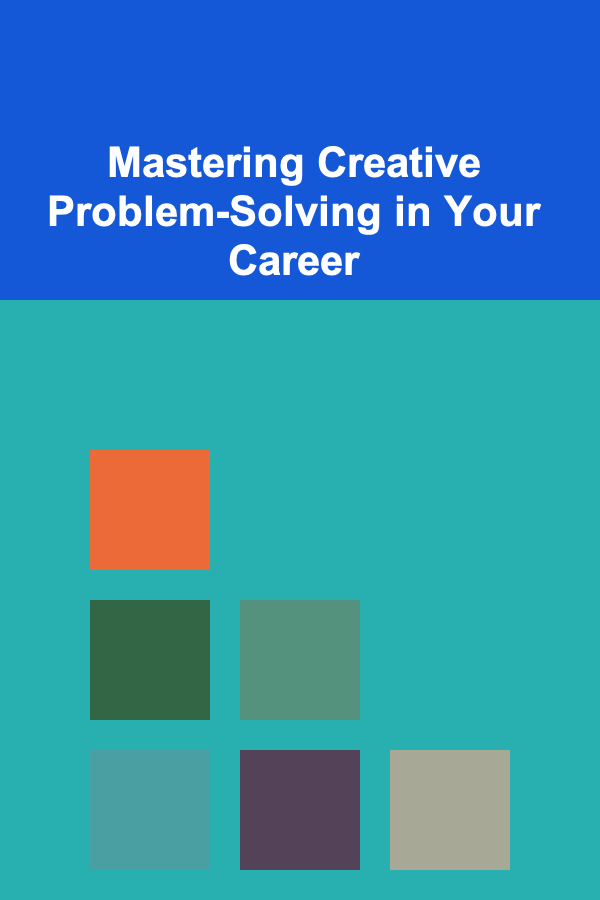
10 Tips for Staying Inspired as an Industrial Designer
ebook include PDF & Audio bundle (Micro Guide)
$12.99$8.99
Limited Time Offer! Order within the next:

Industrial design is a creative field that requires constant innovation, problem-solving, and attention to detail. As an industrial designer, staying inspired is essential to produce groundbreaking, functional, and aesthetically appealing designs. The process can often feel overwhelming, especially when facing tight deadlines, client demands, or a creative block. However, inspiration can be cultivated, and with the right mindset and strategies, you can consistently fuel your creativity and produce your best work.
In this article, we will discuss 10 actionable tips for staying inspired as an industrial designer. These tips will help you maintain a fresh perspective, encourage creative growth, and keep your passion for design alive.
Draw Inspiration from Everyday Life
One of the best ways to stay inspired as an industrial designer is to observe the world around you. Inspiration doesn't always have to come from grand ideas or impressive innovations. Sometimes, the most ordinary objects and experiences can spark your creativity.
Actionable Steps:
- Take a Walk: Walk through different environments, from urban areas to parks, and observe the objects, materials, and design solutions you encounter. How do everyday items solve problems? What materials or forms attract your attention?
- Examine Architecture and Nature: The shapes and structures of buildings, furniture, and natural landscapes can inspire a variety of design solutions. Try to identify patterns, lines, and textures that could influence your work.
By paying attention to the details of everyday life, you'll develop a deeper understanding of design principles and the way people interact with objects.
Stay Curious and Keep Learning
Curiosity is a key ingredient for any designer. The more you learn, the more opportunities you'll have to connect seemingly unrelated ideas and approaches. Staying open to new concepts, materials, technologies, and design philosophies can help you discover new sources of inspiration.
Actionable Steps:
- Read Design Books and Journals: Keep up with the latest trends, theories, and technological advancements in industrial design. There are plenty of design publications, blogs, and online platforms where you can explore the work of other designers.
- Take Online Courses and Workshops: Platforms like Coursera, Skillshare, and Udemy offer online courses in various design fields. You can learn about new design methodologies, tools, and techniques that may inspire your work.
Continually learning helps you refine your skills and exposes you to new ways of thinking, ensuring your designs stay innovative and relevant.
Collaborate with Other Creatives
Sometimes, working in isolation can lead to creative burnout. One of the best ways to rejuvenate your inspiration is by collaborating with other designers, engineers, or artists. Collaboration brings fresh perspectives and new ideas that can reignite your creative spark.
Actionable Steps:
- Join Design Communities: Whether online or in-person, join design forums, attend meetups, or participate in design competitions. Engaging with fellow designers allows you to exchange ideas, gain feedback, and stay motivated.
- Work with Cross-Disciplinary Teams: Collaborate with professionals from other fields such as engineering, marketing, or manufacturing. A collaborative approach often leads to more practical and innovative design solutions.
Collaboration allows you to break out of your creative comfort zone and explore new ways of solving problems.
Experiment with New Tools and Materials
Designers often find inspiration by experimenting with new tools, software, and materials. By stepping outside your usual workflow, you may discover exciting techniques that can breathe new life into your designs.
Actionable Steps:
- Explore New Software: If you're used to certain CAD software or rendering tools, try something different. Software like Rhino, SolidWorks, Blender, or Adobe Creative Suite offers unique functionalities and can help you visualize your ideas in novel ways.
- Work with Different Materials: Experiment with different materials and textures. Whether it's sustainable materials, metals, plastics, or composites, each material offers a distinct feel and design potential. Visit a local workshop or materials library to explore new options.
Don't be afraid to push the boundaries of what you're comfortable with. New tools and materials can help you break free from old habits and come up with innovative solutions.
Embrace Failure and Learn from It
Every designer faces setbacks, whether it's a design that doesn't turn out as expected or a project that doesn't meet client approval. It's essential to view failure as a part of the learning process, not as a permanent roadblock. Failure can teach you valuable lessons that will inform your future designs.
Actionable Steps:
- Analyze Your Mistakes: Reflect on the aspects of your designs that didn't work out. Did you misinterpret the brief? Was the problem-solving process flawed? Learning from mistakes will help you refine your skills and avoid repeating the same errors.
- Embrace Iteration: Understand that the design process is rarely linear. Sketch, prototype, test, and refine your work continuously. Often, the most innovative designs come from many rounds of failure and revision.
By embracing failure as a learning opportunity, you'll become a more resilient and resourceful designer.
Attend Design Exhibitions and Conferences
Exposure to new ideas and designs is essential for any industrial designer. Design exhibitions, conferences, and trade shows provide the opportunity to explore the work of other professionals, stay up-to-date with industry trends, and find inspiration.
Actionable Steps:
- Attend Design Events: Events like Milan Design Week, the International Contemporary Furniture Fair (ICFF), or the London Design Festival showcase the latest design innovations. These exhibitions can provide you with a sense of what's possible and spark your imagination.
- Engage with Designers and Innovators: Take the opportunity to network with other designers, manufacturers, and thought leaders in the industry. Conversations with like-minded individuals can inspire new ways of thinking and working.
Attending design exhibitions and conferences can help you stay connected with the global design community and fuel your creative fire.
Keep a Design Journal
A design journal is a powerful tool for tracking your thoughts, ideas, and inspirations. By writing down your ideas, sketching concepts, and reflecting on your experiences, you can develop a repository of creative fuel to tap into when needed.
Actionable Steps:
- Sketch Daily: Take a few minutes each day to sketch ideas, shapes, or concepts that come to mind. Even if they're not fully formed, putting pen to paper can help clarify your thoughts and generate new ideas.
- Write About Your Experiences: Journal your design process, including the challenges you face and the breakthroughs you achieve. Writing can help you organize your thoughts and keep you motivated during difficult projects.
A design journal helps you track your creative journey and provides a valuable resource for future projects.
Take Breaks and Disconnect
Sometimes, the best way to find inspiration is to step away from your work entirely. Overworking can lead to burnout and stifle creativity. Taking regular breaks and disconnecting from design challenges allows your mind to rest and recharge.
Actionable Steps:
- Engage in Non-Design Activities: Spend time on hobbies or activities that have nothing to do with design. Whether it's cooking, gardening, reading, or sports, engaging in non-design activities can help you return to your work with a fresh perspective.
- Take Vacation Time: If you've been working intensely on a project, it may be time for a longer break. A vacation or a staycation can give you the mental space needed to rejuvenate your creativity.
Remember, rest is just as important as work when it comes to maintaining long-term inspiration and focus.
Study the History of Design
Understanding the history of industrial design and studying the work of influential designers can provide valuable insights into the evolution of design and inspire your own creations. Many great design ideas have been built upon the work of those who came before us.
Actionable Steps:
- Research Iconic Designers: Learn about renowned designers such as Dieter Rams, Charles and Ray Eames, and Philippe Starck. Study their design philosophies, aesthetic choices, and innovative approaches to problem-solving.
- Analyze Historical Trends: Understanding how design has evolved over time can help you contextualize current trends and develop unique design solutions.
Studying design history helps you understand where the industry has been, which can influence where you take your designs in the future.
Stay True to Your Personal Style
While it's important to stay open to new ideas, don't lose sight of your own unique style and design sensibility. As an industrial designer, your personal perspective is a valuable asset. Strive to develop and refine your signature approach to design that reflects your tastes, skills, and values.
Actionable Steps:
- Identify Your Design Philosophy: What values do you want your designs to convey? What materials or forms do you gravitate toward? By understanding your design philosophy, you can create work that feels authentic to you.
- Follow Your Intuition: Trust your instincts when making design decisions. While feedback from others is important, don't be afraid to stick to your vision if it feels right.
Staying true to your personal style helps you develop a distinctive voice in the design world, setting you apart from other designers.
Conclusion
As an industrial designer, staying inspired is a continuous process that requires intentional effort. By seeking inspiration from everyday life, embracing failure, collaborating with others, and keeping an open mind, you can consistently fuel your creativity. Remember, the key to staying inspired is to remain curious, experiment with new ideas, and always be open to learning. With these 10 tips, you'll be well-equipped to navigate the challenges of industrial design and continue producing groundbreaking, innovative work throughout your career.
Reading More From Our Other Websites
- [Home Storage Solution 101] How to Store Your Home's Cleaning Tools Without Clutter
- [Home Security 101] How to Lock Down Your Home When Moving Into a New Neighborhood
- [Needle Felting Tip 101] Beginner's Guide to Needle Felting Wool: Tools, Techniques, and Tips
- [Home Budget Decorating 101] How to Use Fabrics and Textiles to Change a Room's Vibe
- [Personal Care Tips 101] How to Use Antiperspirant Safely in Hot and Humid Conditions
- [Home Security 101] How to Upgrade Your Home's Security Without Drilling Holes
- [Organization Tip 101] Maintenance Tips for Jigsaw and Circular Saw to Keep Them in Top Shape
- [Home Storage Solution 101] How to Maximize Small Spaces with Wall-Mounted Storage Solutions
- [Home Budget Decorating 101] How to Decorate Your Home Office for Productivity on a Budget
- [Tiny Home Living Tip 101] How to Design a Tiny Home Loft That Doubles as a Guest Bedroom

How to Develop a Compelling Sales Pitch That Converts
Read More
How to Transform Your Bathroom with Small Renovations
Read More
Why You Should Regularly Rotate Toys for Child Engagement
Read More
Mastering Creative Problem-Solving in Your Career
Read More
How to Deal with Office Politics Effectively
Read More
10 Tips for a Movie Night Checklist on a Budget: Fun Without Breaking the Bank
Read MoreOther Products

How to Develop a Compelling Sales Pitch That Converts
Read More
How to Transform Your Bathroom with Small Renovations
Read More
Why You Should Regularly Rotate Toys for Child Engagement
Read More
Mastering Creative Problem-Solving in Your Career
Read More
How to Deal with Office Politics Effectively
Read More